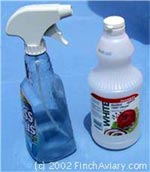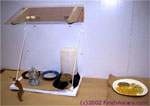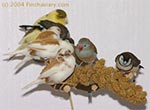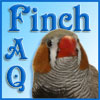See
also Time Commitment for an estimate
of the amount of time spent caring for the birds, including cleaning
and food preparation.
|
|
Weekly
Cleaning Tasks
Walls,
Perches, and Nestboxes | Plexiglas
| Accessories | Floor
| Reward the Birds | A
Note on Disinfecting
Once
a week, I perform a thorough aviary cleaning. This weekly cleaning
is much more intrusive than the daily maintenance tasks and
usually takes between one and two hours to complete. If I have
a particularly hectic schedule on a given week, I can usually
cut a few corners and get everything done in less than an hour,
but I only do this if I must.
|
Tip:
If you have a large (but not too
deep) aviary, you may want to install shades that partition
the aviary into sections. This will reduce the stress
on the birds as well as make your job a whole lot easier.
In general, if you are working on one side of the aviary,
the birds will fly to the other. You can then lower a
shade and work freely without worrying about the occasional
fly-by. Since the birds can't see you behind the shade,
they will be happier as well.
UPDATE:
Using a shade to partition the aviary
has worked extremely well for me. It is not fool-proof,
as the occasional trouble-seeker will sneek under the
shade; however, it is still a lot easier and quicker when
the area I am working in is partitioned off.
|
| Walls,
Perches, and Nestboxes |
 |
| Oxyfresh
Cleansing Gele - A safe detergent for cleaning aviaries
that also has disinfectant properties. |
Droppings
are washed from the perches and the nest boxes with soap
and water (I use Oxyfresh Cleansing Gele, now available
online from Oxyfresh
Worldwide), then rinsed clean. I no longer use nestboxes,
in a very effective effort to inhibit breeding. However,
if you do use them, nest boxes need to be disinfected
or replaced on occasion (every couple of months or when
very dirty). They should be cleaned as thoroughly as possible
each week as illness is likely to spread from an infected
bird to another bird sharing the same nestbox. Since moving
my birds to the new aviary over a year and a half ago,
I have had no contagious illnesses pass from one bird
to another. I attribute this mostly to the removal of
the nestboxes.
Oxyfresh
can also be used as a disinfectant if prepared at the
proper strength and exposed to the clean surface for five
minutes.
Soap
and water is also used to wash the droppings from the
walls and other surfaces within the aviary. If there are
any stubborn droppings, sometimes spraying with the vinegar/water
solution described below and letting sit for a minute
before washing will loosen the droppings a bit.
From
time to time I cut a corner and just wipe down the perches
with water - and only where there are droppings. This
helps me get through weeks that are unusually busy. This
is only used when necessary, as I believe a full wash
with soap and water is more effective at eliminating bacteria,
but if you keep the aviary clean, going a week without
a soap and water cleansing will do no harm as long as
the droppings are removed.
|
| |
| Plexiglas |
 |
| A
solution of vinegar and water. An inexpensive glass
cleaner that is safe for both Plexiglas and the birds.
I pour it into an empty glass/surface cleaner bottle
for convenience. |
Plexiglas panels are cleaned with a solution of 2 tablespoons
vinegar to 1 quart water. I pour it into an empty spray
bottle, spray it on the Plexiglas, and wipe clean with
a dry towel. Always use a soft cloth, such as an old dish
towel, to clean Plexiglas. Paper towel will scratch the
surface over time. The vinegar-water solution is nice
because it is cheaper than surface cleaner, it will not
cloud the Plexiglas like many glass cleaners will, it
does not have any fragrances or chemicals that could be
toxic to the birds, and it works. I like it so well, I
use it to clean all the glass in my house.
As
mentioned above, the vinegar and water solution is also
effective for softening stubborn droppings. I will occasionally
use it to loosen droppings that have stuck tight to the
aviary walls.
|
| |
| Accessories |
 |
The seed hoppers, water dispensers, bird baths, quail bath,
and other removable accessories are all removed and replaced
with clean ones after the floor is cleaned. The contents
are discarded and replaced with fresh seed/sand/water/etc.
The dirty ones are rinsed off and then washed in the dishwasher. |
| |
|
Floor
If
paper is used, the remaining paper should be removed from
the floor and any spilt seed, hulls, bedding, and nest
material should be swept from the floor. I used to use
a shop-vac, left over from the days when I used a bedding
material on the floor, but you must be very careful not
to vacuum a startled bird. Shop-vacs are very handy when
you use bedding/litter on the bottom of the aviary, but
they are overkill if you use paper. (Also, shop-vacs kick
up dust, so I run an air cleaner with a HEPA filter on
high while vacuuming.) I currently use a heavy-duty dustbuster.
The dustbuster is more convenient, but toward the end
of the cleaning, it starts to loose its charge and doesn't
pick up as well, more so as the dustbuster ages. When
I replace it, I will probably replace it with a corded
unit so that I don't have problems with the battery draining.
Once
the floor is exposed and clean of debris, I wipe it down
with soap and water and dry it with a towel (note: this
task does not need to be performed every week and can
be skipped if your schedule is busy. However, I used caulk
to seal the aviary floor, and if I go too long without
washing the floor, the caulk gets very hard to clean).
A new layer of paper is then laid down for the new week.
| Tip:
Lay down a week's work of paper
so that at the end of each day you only need to remove
the top soiled sheet, exposing a fresh layer of paper
beneath it. |
If
bedding is used, ideally all the bedding should be vacuumed
and replaced each week. However, this is very expensive
if you have a large aviary floor, so many people just
spot-vacuum or vacuum the top layer, then add fresh litter
over the old. A complete litter change is put off for
a longer period (eg, once a month).
|
| |
| Reward
the Birds |
 |
| After
the weekly cleaning, the birds flock to a fresh spray
of millet. |
When I am all done, I hang up fresh millet sprays for the
birds. They know it is coming and their enthusiasm for this
treat makes me believe all is forgiven. |
| |
|
A
Note on Disinfecting
Disinfecting
an aviary is a tricky business. Many of the disinfectants
that are toxic to the bacteria that can reside in the
aviary are also toxic to the birds. Those that are not
tend not to be as effective. Bleach is one of the most
potent disinfectants, but it cannot be used when the birds
are in the aviary and the aviary must be thoroughly rinsed
and aired out before the birds can return.
Because
of the impracticality of relocating the birds to disinfect,
I use Oxyfresh products to disinfect my aviary. Oxyfresh
is safe to use while the birds are present. Oxyfresh is
available in the concentrated form of Dent-a-gene. This
product emits toxic fumes when it is mixed, so you must
not mix the solution in the presence of your birds, but
after the solution is prepared, it is safe. Dentagene
must remain in contact with the surface being disinfected
for a minute in order to be effective. Alternatively,
you can use a concentrated preparation of Cleansing Gele
and water (1 tablespoon to 1 quart of water). Cleansing
Gele must remain in contact for 5 minutes before it is
effective, however. The downside of Oxyfresh products
are that they are not cheap. For more information, see
this article by Ross Bishop reviewing the different options
available for disinfecting aviaries: Biosafety
in the Aviary.
I
used to disinfect on a regular basis. I now believe that
this may not be a good thing. As long as the aviary environment
is kept clean, my birds have done fine without regular
disinfecting. The idea is that exposure to some bacteria
is healthy, as it helps the birds build natural immunities.
This does, of course, assume that the aviary is kept clean
so that the bacteria does not have a chance to build up
in large numbers. If illness should strike, however, then
I believe disinfecting is very important to deter the
spread of the illness.
|
Click
Previous to return to the Daily Cleaning Tasks Page | Click
Next for the Illness Section
PREVIOUS  |
|  NEXT
NEXT
 TOP TOP
|
|
|
How
do you care for your birds?

Vote
in our survey or view the results!
|
|
| |
See
Also:

For answers to some
commonly asked questions!
|
|
|






